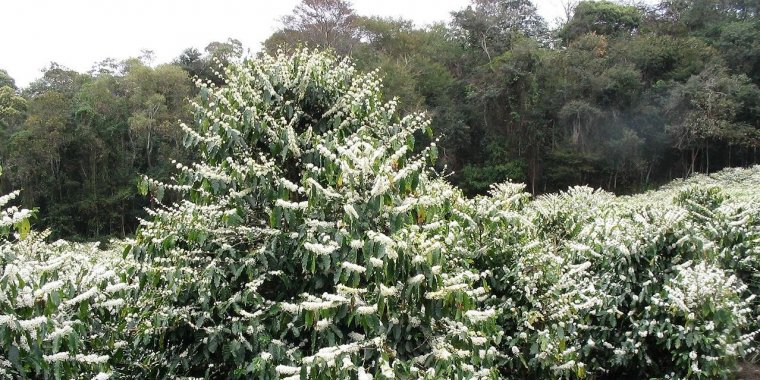| Nutrition / Plants and plant products |
Coffee - Benefits and Drawbacks
Coffee consumption varies significantly across different age groups, each experiencing benefits and drawbacks. This article explores the some of the health implications of coffee consumption for children, young adults, and older adults.

A flowering Coffea arabica tree. Photo credit: FCRebelo/Wikipedia
Antioxidant Effect for All
Coffee is rich in antioxidants, which can contribute to overall health by combating oxidative stress1 and inflammation.
Studies suggest that regular coffee drinkers may experience a lower risk of certain chronic diseases, including type 2 diabetes and cardiovascular issues, as they age.

Data source: https://www.researchgate.net/
Polyphenols are strong antioxidants that can neutralize free radicals and reactive oxygen species and are one of the body's first lines of defense against oxidative stress damage.
Some of the ways polyphenols benefit health include:
• Protecting against chronic diseases: Some studies suggest that diets rich in polyphenols may help protect against the development of certain cancers, cardiovascular diseases, diabetes, and neurodegenerative diseases.
• Combating environmental harm: Polyphenols can help combat environmental harm such as UV light damage and pollution.
• Protecting red blood cells: Polyphenols may protect red blood cells from oxidative damage.
In addition to polyphenols, coffee contains other antioxidants, like chlorogenic acid (anti-inflammatory, antibacterial), caffeic acid (boosts collagen, reduces cell aging), trigonelline (gives coffee its unique smell ) and Maillard reaction products that form during roasting.
Benefits of Coffee Consumption
For Young Adults
Young adults, particularly those aged 19 to 30, are among the highest consumers of coffee. The primary benefits include increased alertness and improved cognitive performance due to caffeine's stimulant properties.
Research indicates that moderate coffee consumption can enhance mood and reduce the risk of depression, which is particularly relevant for this age group facing academic and social pressures.
For Older Adults
The benefits for this demographic are substantial. Research has shown that coffee consumption is linked to a reduced risk of Alzheimer's disease and other forms of dementia, attributed to its ability to slow the accumulation of amyloid proteins in the brain.
Furthermore, coffee has been associated with lower overall mortality rates, particularly in individuals aged 45 and older, suggesting protective health benefits that may arise from its bioactive compounds.
Regular coffee consumption can also enhance energy levels and improve mood, which is vital for maintaining quality of life. Additionally, coffee may support liver health, a significant concern as people age.
Drawbacks of Coffee Consumption
For Children and Adolescents
The consumption of coffee among children and adolescents has notable drawbacks. Caffeine can lead to increased anxiety, disrupted sleep patterns, and elevated heart rates, which are particularly concerning for developing bodies.
The American Academy of Pediatrics advises against caffeine consumption for children, citing a lack of comprehensive research on its long-term effects.
Moreover, many caffeine drinks marketed to younger audiences are high in sugar and calories, contributing to obesity and other health issues. Given that children are more sensitive to caffeine, even small amounts can have pronounced effects, making it crucial to limit their intake.
For Young and Older Adults
While young adults may enjoy the benefits of coffee, excessive consumption can lead to negative health outcomes such as insomnia, anxiety, and digestive issues.
High caffeine intake is also linked to increased blood pressure and heart palpitations, particularly in individuals with pre-existing health conditions.
For older adults moderate intake is generally safe, but excessive coffee can lead to adverse effects such as increased heart rate and anxiety, especially in those with hypertension or heart arrhythmias.
The Mayo Clinic recommends limiting coffee intake to no more than four cups per day for older adults to avoid overstimulation of the nervous system.
Summary
Coffee consumption presents a complex mix of benefits and drawbacks across different age groups.
For young adults, moderate coffee intake can enhance cognitive function and mood, while older adults may experience protective health benefits against neurodegenerative diseases.
However, children and adolescents face significant risks from caffeine, necessitating caution in their consumption. As with many dietary choices, moderation is key, and individual health conditions should guide coffee consumption decisions.
Sources
• https://www.ncbi.nlm.nih.gov
• https://nutritionsource.hsph.harvard.edu/
• https://www.hopkinsmedicine.org
• https://www.researchgate.net
• https://www.cancer.gov
• https://en.wikipedia.org
Footnotes
1. Oxidative stress is a condition that occurs when the body has too many free radicals and not enough antioxidants to neutralize them. This imbalance can lead to cell and tissue damage. Oxidative stress can be caused by gamma or UV radiation, environmental factors, polluted and poor-quality food, stress, some medications or treatments, smoking, alcoholism, etc.
YOU MAY ALSO LIKE





